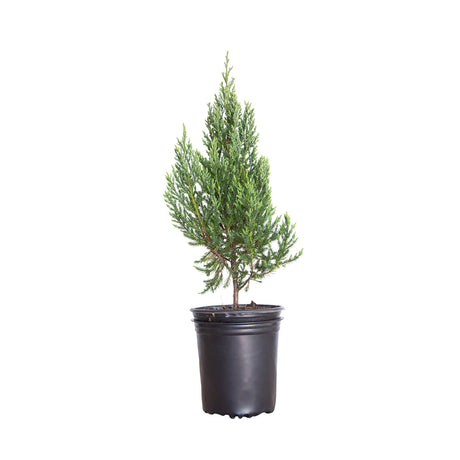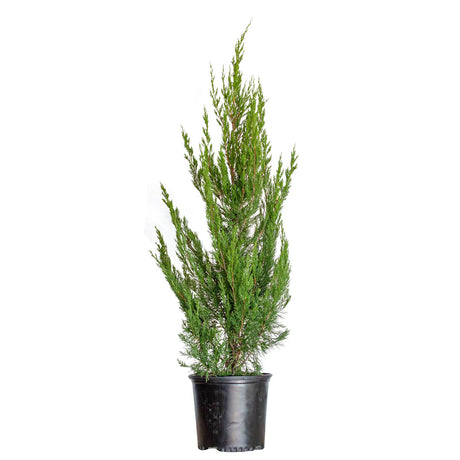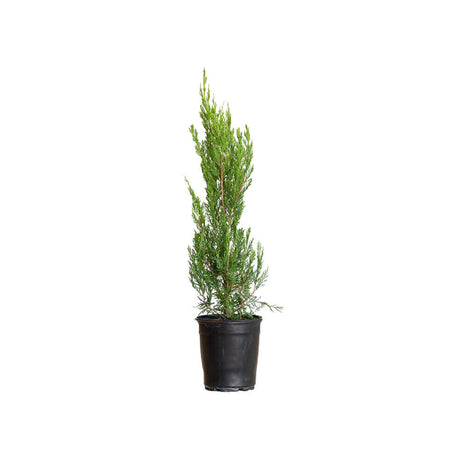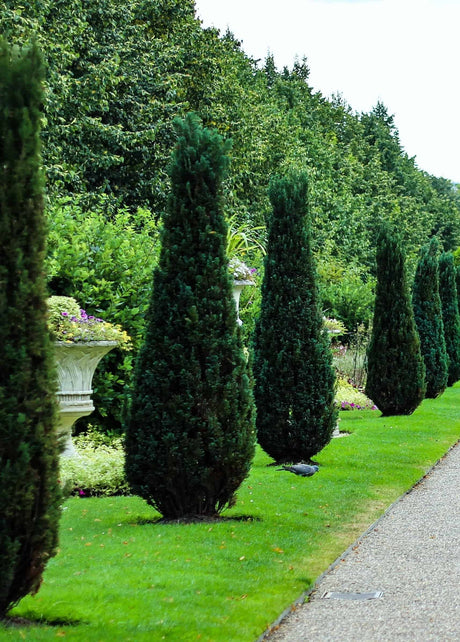Flowerwood
Living Christmas Tree - Blue Point Juniper
(1)$24.99Unit price /UnavailableIn stock (69)Flowerwood
Green Hetzi Columnar Juniper Tree
(1)From $19.99Unit price /UnavailableOut of Stock (0)
Juniper Trees are easy-care, easy-growing evergreens that come in virtually every shape and size. Looking to plant a privacy screen? There's a Juniper for that! Want a classy container plant? Junipers have you covered. Need a low-maintenance landscaping specimen? Look no further!
This species is characterized by young foliage that emerges needle-like and sharp. Some varieties retain this needled texture, while others mature to awl-shaped leaves that are fanned and arranged in groups. Some varieties are sterile, while others produce attractive waxy blue seed cones, called Juniper berries. These berries were used historically to flavor foods and, notably, gin. Both the foliage and wood of Junipers are known for their piney fragrance.
Looking for a low-growing variety? Check out Groundcover Junipers to browse those selections.
Why Should I Plant Juniper Trees?
With beautiful green foliage that lasts year-round and the ability to thrive in some of the most difficult areas it is hard option to pass on. Tall Juniper trees are perfect for screens, hedges and foundation plants.
Juniper Trees Are Low-Maintenance
Most varieties are naturally pyramidal, so you can leave the trimming shears in the shed. Many selections also max out between 12-16 feet tall at maturity. Therefore, you can rest easy knowing that they won't eclipse your entire landscape.
Fast Growing Juniper Trees
Although not as fast-growing as a Green Giant Arborvitae or a Leyland Cypress, Juniper Trees are no slouches when it comes to quick growth. Additionally, their moderate mature height means that they'll get to the size you want them to be relatively quickly and then they'll stay that size.
Juniper Tree Uses
Junipers are compact in nature, so they really shine when use as privacy screens. Their thick foliage is perfect for dampening street noise, filtering dust and pollutants out of the air, and blocking out heavy winds. Plus, the fact that they're evergreen means that you'll have coverage all year long!
What Type of Juniper Tree Should I Plant?
If you're looking for dense, pyramidal green foliage, you should look at either the Spartan Juniper or Green Hetzi Columnar Juniper. Both of these varieties reach approximately 15 feet tall at maturity.
The Spartan tends to be the narrower growing of these two. If you want the classic Blue Juniper tree foliage color in your landscape, check out the Blue Point Juniper. This beauty brings that bright blue color all year long.
Where Should I Plant Them?
Juniper Trees grow well in full sun exposure. This is the best way to ensure that they have healthy and uniformly dense foliage. They tend to struggle with less than 6 hours of direct sun exposure.
They are generally tolerant of most soil types, so that isn't usually a major concern when choosing a planting location. However, good drainage is important to ensure that they don't experience root rot. If they're planted in poor quality soil, consider applying a nitrogen-rich fertilizer a couple of times during the growing season to help provide your plant with the nutrients it needs to grow. This becomes generally unnecessary once the plant has reached its full growth potential.
When Should I Plant?
Spring and Fall are the ideal seasons to plant Junipers. The mild temperatures in these two seasons allow the plant to acclimate to the landscape before extreme Summer or Winter temperatures set in.
- Spring Planting: Spring is generally a better time for planting in colder regions, such as USDA Zones below 7. It gives your plants ample time to establish themselves in the landscape before the bitter cold of winter. Plant after your last expected frost of the year. Summer tends to be milder in these zones as well, so it poses less of a risk to your plant. If you plant in Spring and you're above USDA Zone 7, be sure you're keeping an eye on your plants during the summer heat. They may require more frequent watering.
- Fall Planting: Fall planting is ideal for USDA Zones above 7 because they tend to have milder winters and more intense summers. During fall, the ground is nice and warm so your plant's roots can spread easily but the air temperatures have cooled off somewhat. Regardless of your zone, we recommend planting at least 1 month before your first expected frost date. This will give your plant time to situate itself in the landscape before freezing temperatures start to roll in.
How Do I Plant Juniper Trees?
- To get the most out of your Trees, make sure that you’ve chosen the correct one for your growing conditions.
-
Dig a hole three times the width of the root ball (the clump of roots and soil in the pot) of your plant.
- The hole doesn't need to be any deeper that will allow for the plant to sit flush with the ground around it. However, if you have slow drainage in your planting location, consider digging a slightly shallower hole so that your plant will sit 3-4 inches above the native ground. Then, mound dirt around the base of the plant.
-
Mix your native soil with some rich gardening soil to provide extra nutrients.
- This step isn’t 100% necessary for Junipers. They do well in a wide range of soil qualities. This step will help your plant get started on the right foot in your landscape, though.
- Backfill the hole with the dirt mixture and top with 3-4 inches of mulch to help retain moisture.
-
Water your new planting 2-3 times per week for the first growing season.
- Monitor your plants for the first couple of weeks. If your soil seems to be retaining a lot of water between waterings or if you've been getting a lot of rain, decrease your watering frequency. If they seem to be drying out quickly and you've had dry weather, you may need to increase your watering frequency.









